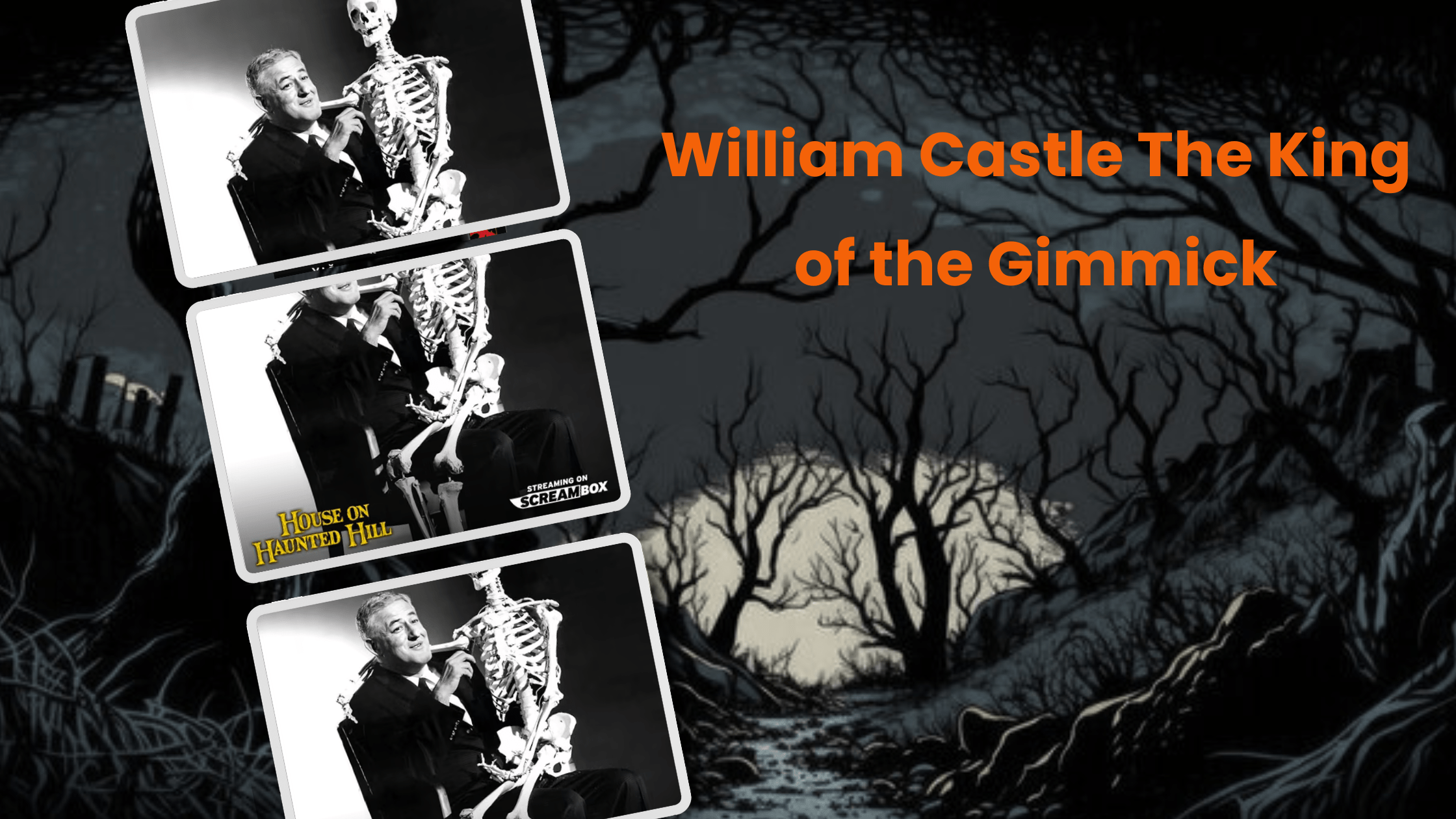King of the Gimmick
House on Haunted Hill and The Tingler: William Castle and the astonishing! trick! of! telling a surprisingly decent story!
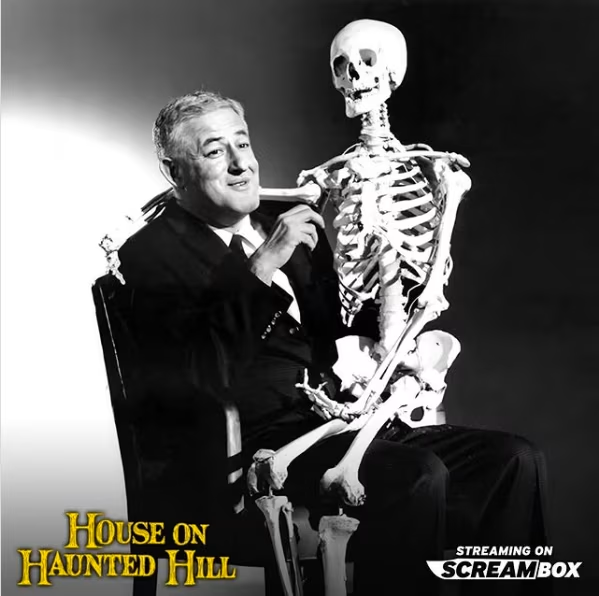
I hope you enjoy it. And I hope your nightmares are nice ones.
William Castle, introducing ‘Mr Sardonicus’
William Castle is one of those directors most of us have heard about but not actually seen. If you’ve heard of him it’s probably for one of two reasons:
- 1. At the end of his career he produced Rosemary’s Baby. In fact he originally wanted to direct it, but instead Roman Polanski was put at the helm. Roman Polanski as a man did terrible things; Roman Polanski as a director made amazing movies.
(That’s not an excuse: if they hadn’t been so amazing he wouldn’t have got away with so much.) Rosemary’s Baby is a combination of pulp and arthouse that makes for one of the most resonant horror films ever made, and Castle got it into production. We must hope he didn’t know what kind of person he was dealing with – and we must also admit that if Castle had directed it, it wouldn’t have been that good.
- 2. For much of his career Castle was ‘King of the Gimmick’.
He’s the guy who offered refunds for viewers too scared to finish watching the movie Homicidal (1961), but only if they followed a ‘yellow streak’ on the floor, stepped over stencils reading ‘Cowards keep walking’, a recorded voice shouting, ‘Watch the chicken! Watch him shiver in Coward’s Corner!’, and finally sign a certificate reading, ‘I am a bona fide coward.’
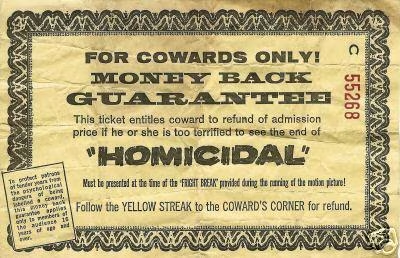
He’s the guy who let audiences vote on the fate of the villain in a ‘Punishment Poll’ at the end of Mr Sardonicus (1961). (Though he almost certainly never bothered to film the ‘merciful’ ending; he’d never need one, as Castle himself appears on screen to conduct the poll and imply that if you vote for mercy you’re no fun at all.)
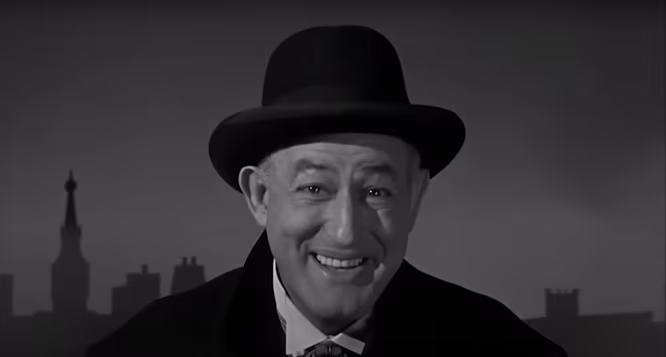
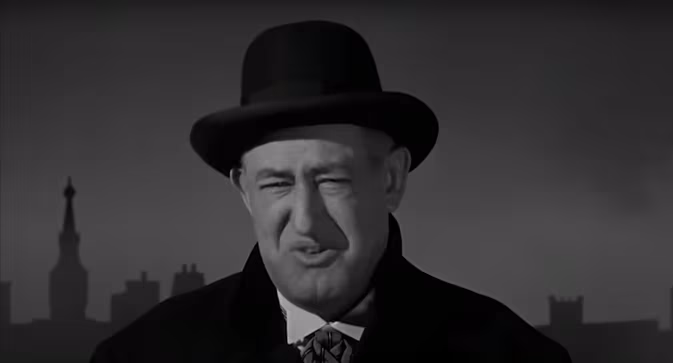
He’s the guy who commissioned Robert Bloch, author of the novel Psycho on which Hitchcock based the movie, to write the tagline: ‘Just keep saying to yourself . . . it’s only a movie . . . it’s only a movie . . .’ This was for Strait-Jacket (1964), but the line was so good that in 1972 Wes Craven half-inched it for his grisly The Last House on the Left, cementing its place as one of the most famous dares in cinema history.
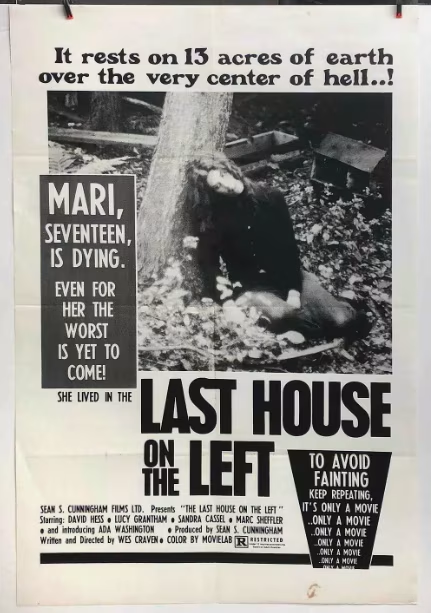
He’s the guy who dangled a skeleton over the audience and called it ‘filming in EMERGO!’ That was for House on Haunted Hill (1959) – which is one of his best known, and also is happily on Shudder, so let’s talk about it.
While we’re at it, I thought we’d throw in another: The Tinger (also 1959).
A few reasons for this. First a practical one: it’s public domain and on YouTube (here you go – https://www.youtube.com/watch?v=qshrNdQzIng), so it’s easy to find.
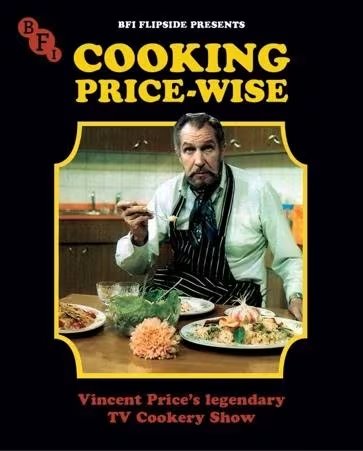
Another is that like House on Haunted Hill, it stars Vincent Price, and if the man ever gave a performance that wasn’t an absolute treat from start to finish I haven’t seen it.
But I did have a better motive in mind than simple fandom:
Castle is one of those directors more talked of than watched.
He’s a horror legend, and if you’re interested in the genre then you will hear about him at some point – but the man himself is more famous than his movies. I figured that as long as we were talking about him we might as well take in more than a glance. Castle put a lot of creativity into those gimmicks, but he bothered to make the movies too, and having so enjoyed the idea of the gimmicks it seemed only fair to watch at least a couple of the movies.
And why The Tingler? Well, I decided to stick to two because last time I took in seven movies and there are limits. I picked this one because, availability and cast aside, this is the movie in which Castle did his game best to convince the audience that everyone – not just the characters, but every human being in the real world – has a horrid insect-monster in their spines that grows bigger when they’re afraid. He called it ‘the Tingler’, a name that only makes sense as a hint you might feel it through a tickling sensation.
Then the bastard rigged certain seats in the cinema to vibrate against the audience’s backs, shot a scene where the monster escaped into a diegetic movie theatre – including crawling across the movie screen – and set them off.
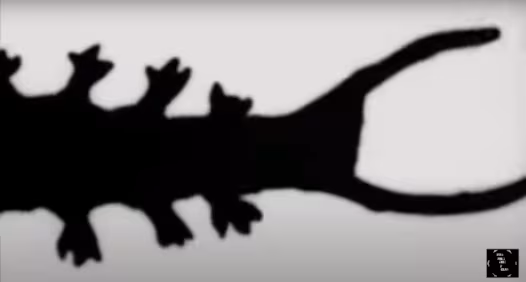
If you’re not in love with the idea of William Castle’s movies after hearing all that, I don’t think we can be friends.
But the idea of his movies is one thing; what of the movies themselves? That’s what I was curious about.
Was Castle any good?
The thing about gimmicks is that they’re often used to distract from an inferior product; I went on at length about how Tom Six did this with The Human Centipede (https://gnofhorror.com/helping-you-feel-better-about-the-human-centipede/– I promise there are no screencaps or graphic descriptions in that review).
So it’s easy to assume that a gimmick to get you into theatres means that what’ll be screened once you’re in there isn’t something you’d watch if you hadn’t been bamboozled a bit.
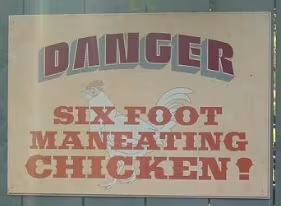
Source: https://themeparkreview.com/forum/topic/13066-six-flags-stl-six-foot-maneating-chicken/
We hear about Castle as the King of the Gimmicks, and from that we might assume that’s all he was.
The man could sell a movie all right, but could he actually direct one?
Turns out he could.
I’m not here to pretend he was in the same class as Hitchcock or Polanski. We can thank Castle for Psycho (1960) in a way – it was his and Roger Corman’s successes that convinced Hitchcock a B-movie shocker was financially viable – but Psycho and Rosemary’s Baby are more famous for a reason. There were better directors out there and their movies are unforgettable. Horror can touch us deep.
House on Haunted Hill and The Tingler are campy and silly and about as deep as a teaspoon.
But my giddy aunt are they determined to give you a good time.
And that includes some solid storytelling – even when the story itself is bananas.
They’re an interesting contrast, in fact, because one of them has a very sound plot and the other plot is pure snooker-loopy. Let’s take them in turn.
House on Haunted Hill is pretty much the cinematic equivalent of a ghost train at a fairground, and it would probably take that as a compliment – but the story is in its way almost sensible.
I don’t want to spoil all its twists and turns because they’re too much fun. I’ll just say that it is (or is it . . . ?) what historians of Gothic fiction refer to as ‘the explained supernatural’, which has a pedigree from Ann Radcliffe to Scooby-Doo: it might seem like there are ghosts and goblins, but actually it’s all stage magic perpetrated by some human behind the curtain. Event follows event quite logically, however wacky each event is on its own, and there’s a clear through-line that keeps you interested in the plot as well as the jumps.
And my goodness does Castle know how to set out a stall. Here’s how we enter the House on Haunted Hill:
The screen appears before us, blank and black.
The auditorium fills with ghoulish sounds: screams, groans, clanks and cackles.
The face of a harrowed-looking man appears onscreen, introducing himself as Watson Pritchard (Elisha Cook Jr), promising that ‘in just a minute I’ll show you the only really haunted house in the world.’
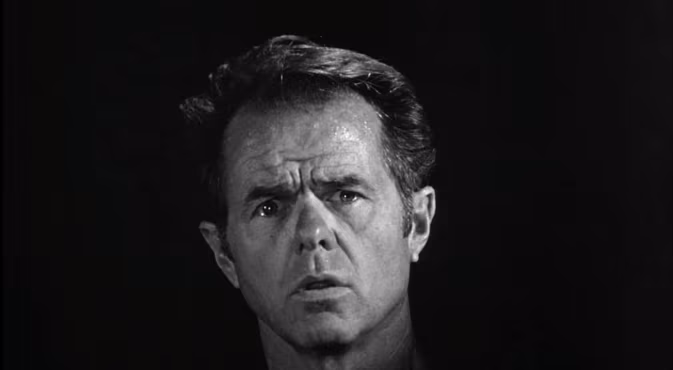
He warns us of its dark history: seven people have been murdered there in mysterious circumstances.
Then we see the house itself, musical stings coming along for the ride, and Vincent Price’s face appears over it to introduce himself. The exterior is actually Frank Lloyd Wright’s Ennis House, inspired by Mayan temples and darkly imposing in the night; it’s a building so potent-looking that it crops up in all sorts of movies, most famously Blade Runner (1982).
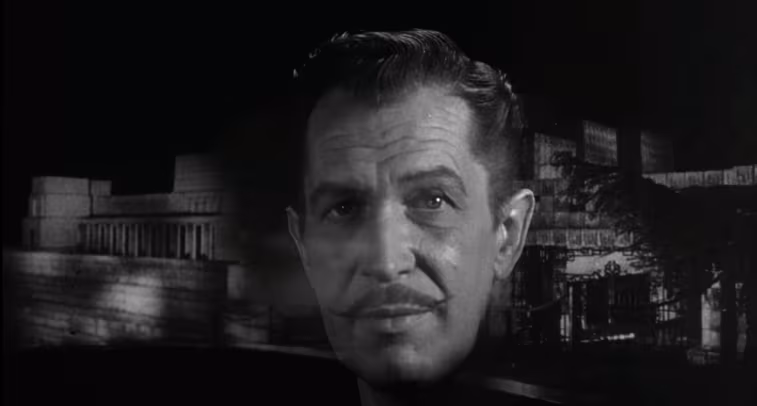
‘I’m Frederick Loren,’ he tells the audience, speaking to us as if we’re also invited guests. ‘And I’ve rented the House on Haunted Hill tonight so that my wife can give a party. A haunted house party.’ He smiles and adds, with the kind of suave venom only Price can deliver, ‘She’s so amusing.’
There we have it, crisp and clean: background, set-up and the beginnings of character tensions, and we’re less than two minutes in.
From there Loren/Price talks us through the various ‘other’ guests who are arriving besides ourselves, each driven in their own rented hearse; he’s offered each of them ten thousand dollars if they can last the night there.
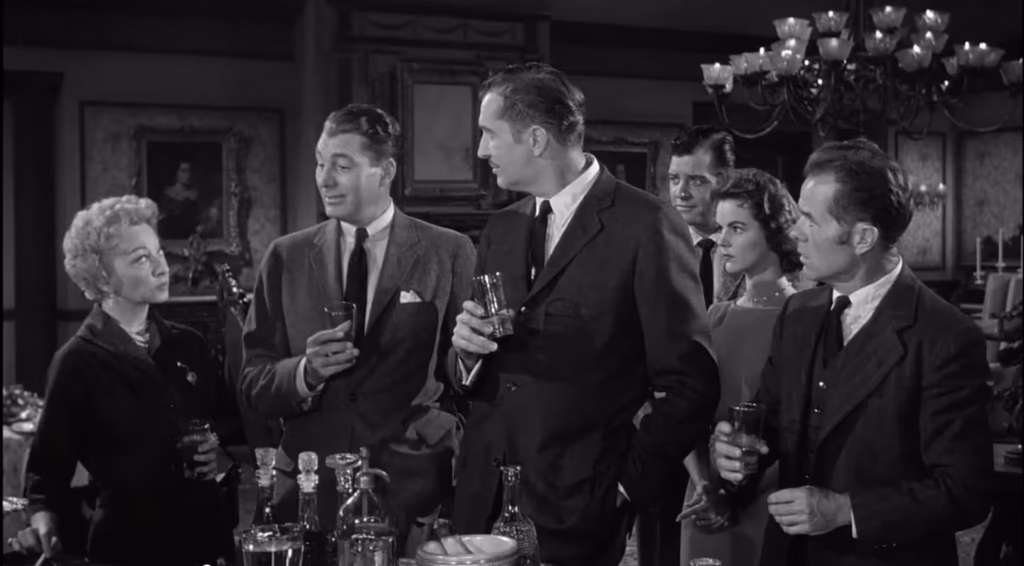
If we’re going to follow the story instead of just the premise we need to know why we should be interested in the characters, yes? Well, Castle understands this. Each has their own little bit of background that Price narrates with silky cynicism as we see them driven up.
A lady newspaper columnist with gambling debts; a smooth psychiatrist supposedly researching hysteria (but is it that his true reason?); a square-jawed test pilot used to being brave for pay; a pretty young employee of Loren’s who needs money for her family; Watson Pritchard, reluctant inheritor of the mansion, risking his life to stay for unknown reasons except that the hosts are providing the booze. Some seem honourable – or are they? – and some definitely don’t.
And so we join them, our fellow-guests, knowing exactly what this movie is going to offer us in terms of premise, setting, story hook and cast. It’s four minutes, and we’re absolutely clear what’s on the table.
This is the real stuff. Economical, intriguing, and polished to a shine. Efficiency is one of those storytelling skills that editors talk about in the hopes that audiences will be too entertained to notice it’s there, but it’s one of Castle’s great hallmarks – and if we don’t always notice it when it’s there, boy do we feel its absence. There’s a word for that feeling: boredom.
Castle isn’t too proud to bid hard for our attention, and he does it like a pro.
After that?
Well, I actually don’t have the heart to tell you the story, because it turns out to be a lot of fun. There are twists and turns and double-crosses every which way. There’s an implied romance between the square-jawed pilot and the pretty employee, but Castle is so intent on the thriller aspect that he doesn’t bother to develop it, and that’s for the best because with possible ghosts every which way, who cares? The only other important thing to know: the Lorens, our host and hostess (the latter played by Carol Ohmart), are at each others’ throats from the get-go.
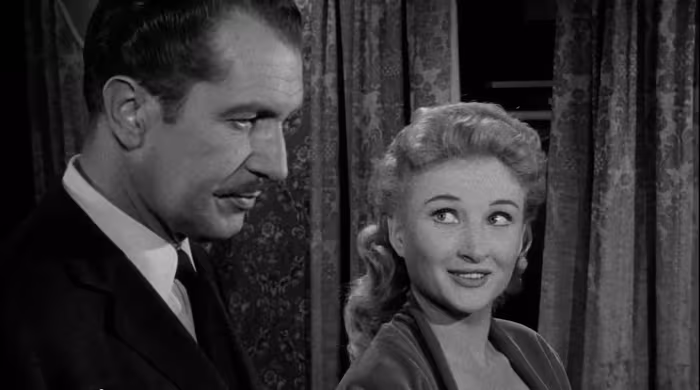
‘But still alive.’
Loren was married three times before, and each of his wives died of an apparent heart attack in their twenties. Is he afraid of her, or is she afraid of him? Matters will develop.
Couples who’d really like to see each other dead are a staple of Castle storytelling; in The Tingler we’ll get more of them. (I wonder if that’s one reason why he originally put in to direct Rosemary’s Baby? Because if you haven’t seen it, well, if you had to play a party game where you described a movie in a single catchphrase, ‘The worst husband on God’s green earth’ would probably do it.) He’s pretty even-handed about who’s up to shenanigans, though – which is usually everyone. It’s more fun when no gender keeps all the villainy to itself.
The other thing House on Haunted Hill is famous for is its jumpscares.
Apparently the ‘EMERGO!’ skeleton-dangling device Castle wanted to use failed more often than it worked, but that hardly matters: the jumpscares can hold their own.
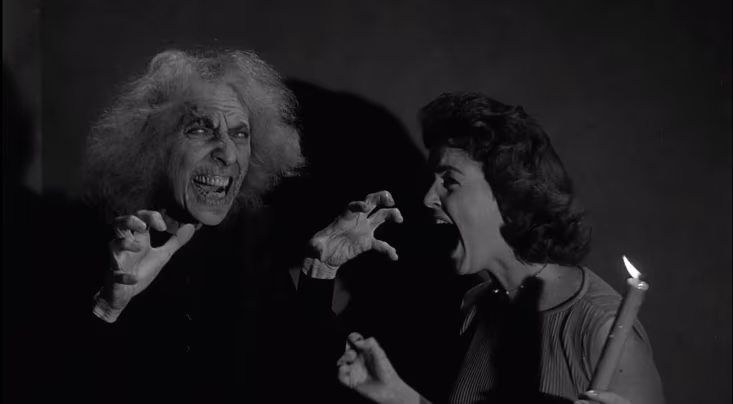
But here’s the other thing: the scares link together. They seem random at first, but that’s because they’re mysterious at first. After a while a plot begins to emerge – a ‘plot’ in both senses, because there are a lot of schemers under this roof – and it becomes clear that every jump and flinch was there for a narrative reason, not just to goose the audience.
And that’s surprisingly satisfying.
It is realistic? Heck no; it isn’t trying to be.
Is it fun? Heck yes; that’s what it wants to be, and that’s what it is. For all its reprehensible characters and startling shocks, it feels like a very friendly movie: all it wants you to do is have a great time.
So let’s take a bathroom break, top up our popcorn, and settle in for The Tingler.
Because here we have to look at the other side of things. House on Haunted Hill’s story, when you reach the end, is more naturalistic and logical than you thought . . .
But the story of The Tingler is two things simultaneously.
Number one: it is absolutely and completely ridiculous.
Number two: it holds your attention like a juggler, never breaking pose long enough for your interest to drop.
I’ll try to explain the plot in a moment, but first it’s more important to understand the purpose of the plot. It’s the same reason my little friends and I used to scream when someone made the first cut into a birthday cake, shrilling away at the tops of our lungs. We weren’t afraid of cake. It was a tradition based on the primordial pleasure of ritualised racket.
To watch The Tingler is to enter into a space of pure play.
There are movies that ask you to believe something unbelievable because they’re badly written, but that’s not what’s happening here. The Tingler asks you to believe – or pretend to believe – so that at the end, you can pretend something real is attacking you. Then you get to yell your head off.
In other words, Castle has to appeal for all he’s worth to your suspension of disbelief. And that was true for his original audience as well: the climactic scene involved seats rigged with buzzers, but not every seat in the auditorium was gaffed. He couldn’t rest on the assurance that everyone in the cinema would literally believe there was a monster after them.
No, The Tingler rests on the logic of a rollercoaster: sometimes people like to get together and have a good safe scream. Castle assembles everything he can to get to a point where he can black out the screen, play shrieking voices, and invite you to add your own voice to the mix whether your seat is buzzing or not.
It’s all kayfabe. So he has to make you want to play along.
Castle begins with a trick that dates back at least as far as James Whale’s 1931 Frankenstein: a gentlemanly figure appears on-screen to deliver ‘just a word of friendly warning’.
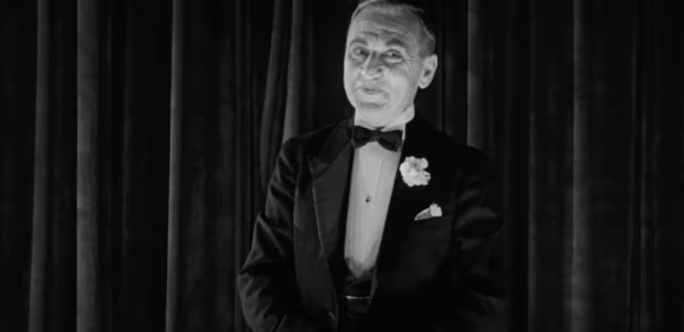
An oldie but a goodie. And in this case Castle really needs to pitch, because he’s got joy-buzzers in the seats. So we begin with him appearing on screen and saying right to our faces that he wants us to expect ‘certain physical sensations.’
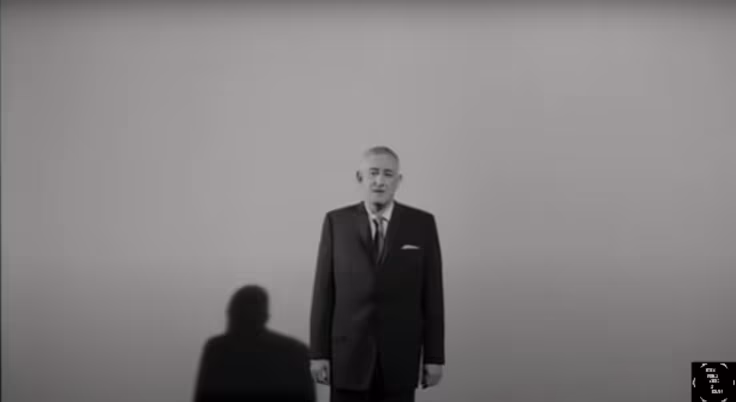
It’s a delicate balancing act: he needs to prime the audience so that they know any tickle in their back is part of the movie, not just a random event, but he also needs to give an excuse to pretend that it’s not just part of the movie.
These ‘physical sensations’, he tells us, ‘will also be experienced for the first time in motion picture history by certain members of this audience. I say “certain members” because some people are more sensitive to these mysterious electronic impulses than others. These unfortunate, sensitive people will at times feel a strange tingling sensation . . . You may obtain immediate relief by screaming. Don’t be embarrassed about opening your mouth and letting rip with all you’ve got.’
There we have it. He’s telling us we’re in the spook house and we’ll help if we take part in the performance, but he’s given us a bit of a diegetic fig-leaf.
Now how on earth do you build a story around that device?
Meet Dr Warren Chapin – Vincent Price again.
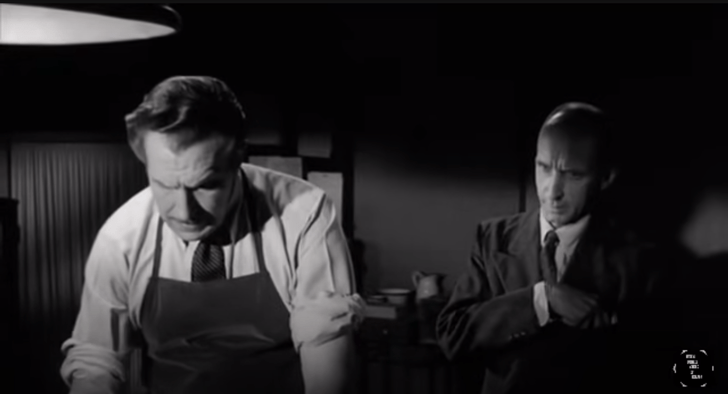
He’s a mild-mannered pathologist, at least some of the time, and he’s involved in a curious scientific journey. In his dissections – which are of executed criminals – he sometimes finds that their backs are broken, not by the execution process but apparently by pure fear.
(Excuse the italics; we might as well get into the spirit of things.)
What is causing this fear? What is the mechanical process of fear within the human body? Why do we scream? And why, when we can’t, do we seem sometimes to die of it?
That’s the subject he’s researching, aided by his handsome assistant David (Darryl Hickman). They desperately need test subjects.
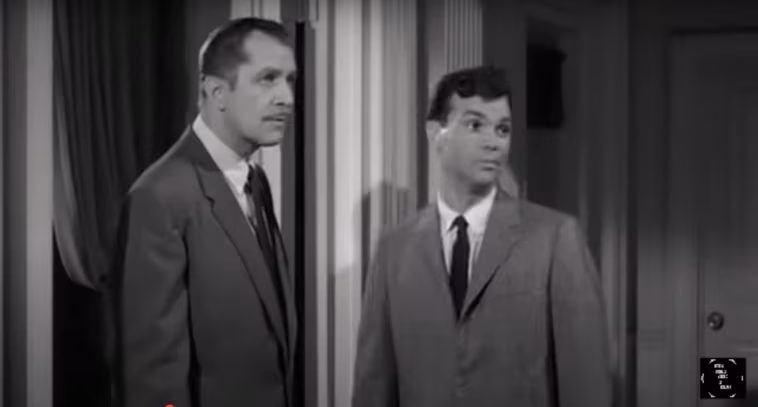
There’s a family story going on too: Chapin is married to an unfaithful woman who refuses to give her much nicer little sister a fair share of the family fortune; the nice little sister is engaged to David.
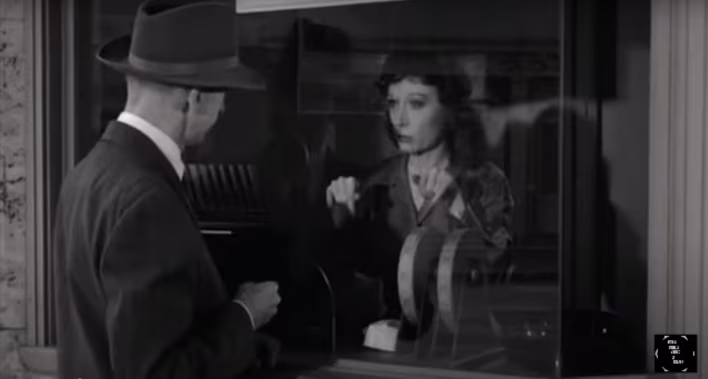
Chapin also befriends a local silent-movie theatre proprietor, whose wife is what they refer to as ‘a deaf mute’; she can’t hear, and she also can’t talk. So she can’t scream! Don’t assume for a second this won’t come back to haunt us! She’s also the sister of the corpse we see Chapin dissect in the first scene; the guy committed some murders and we never find out why, because Castle isn’t here to waste our time with such trivial questions.
Sound complicated? It is a bit, but it both does and doesn’t matter.
This is a film that swings violently from tone to tone: Price as Chapin is gentle and unassuming in one scene and coldly pitiless in another according to the needs of the story, and there’s only one real story going on here: the slow discovery of what ‘the Tingler’ – the force that kills the fearful – really is.
Because of this, the plot is a wild ride. Here’s Chapin’s extremely coherent work schedule:
- Dissect the executed corpse of a murderer in front of said corpse’s brother-in-law.
- Offer minor medical assistance to a deaf woman who passes out at the sight of blood, kindly declining payment and joking you’ll only charge a couple of tickets to her cinema.
- Check in with your assistant, who’s captured an alley cat for experimentation, and wish him an enjoyable date with your dear little sister-in-law.
- Shoot blank bullets at your unfaithful wife and X-ray her spine as she lies in a faint.
. . . and it goes on from there. Chapin and David just keep trucking with a phlegmatic dedication Frankenstein himself would admire.
Deadly enmities and scientific discoveries and strange complications all lead to one simple end: this flippin thing.
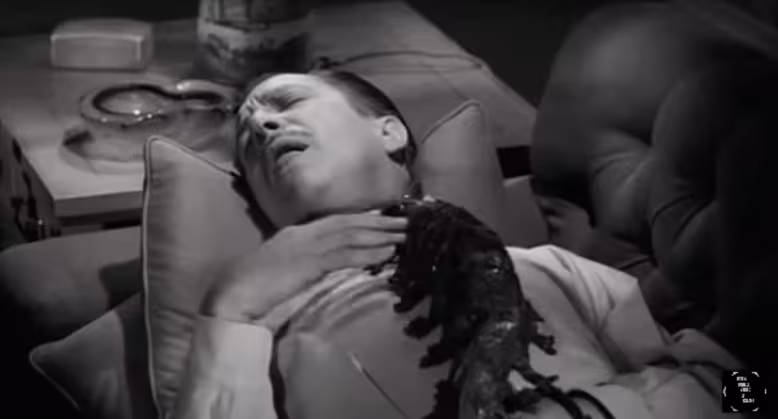
Yep, it turns out that inside the human body is a kind of wiggly insectile beastie that lives upon the spine. If you’re calm it’s tiny; if you’re afraid it grows massive. It’s unkillable and adamantine-strong; the only thing that paralyses it is the sound of a scream. That’s why we scream: to subdue the Tingler.
You’d think we were in the realms of deep sci fi here. But The Tingler plays it dead straight.
It has to, otherwise the audience couldn’t pretend that the creeping on their own spines wasn’t a real Tingler.
Which is, narratively speaking, a bonkers choice. The idea of being parasitised by a nasty crawly thing is solid horror that gets used plenty; David Cronenberg did it to great effect Shivers (1975), for instance, and plenty of body-snatcher invasion movies take a crack at it too.
But that’s an alien invading you, not a part of your own body you just never realised was there. That would be daft.
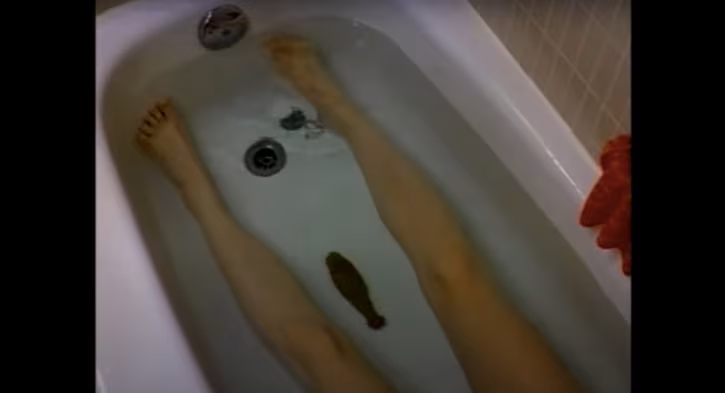
The Tingler is obviously a rubber puppet that the actors are shaking around, but they do it with conviction – and they talk about it as if scientifically speaking, they’ve just made the ground-breaking discovery that all human bodies contain a Tingler already.
This is bats. But while it’s much sillier than House on Haunted Hill, it shares a common quality: the story moves from scene to scene driven by a cause and effect that has obvious, if screwy, thought behind it. Each event is the consequence of previous events.

Because here’s the key: it doesn’t have to make logical sense. All it has to do is keep us involved just long enough to get to the set-pieces. If it can drop us off there, that should be enough to send us out of the theatre with smiles on our faces – which for William Castle meant a job well done.
There are two set-pieces, and one of them holds up better than the other.
The second, and less enduring, is the scene in the movie theatre, and the problem with it is that Castle couldn’t have known that one day he’d be on home viewing.
It needs to be viewed on its own terms – and its own terms rely on an auditorium.
A single Tingler has been extracted from a terrified corpse – I won’t go into how or why, it doesn’t really matter – but it’s escaped into the silent-movie theatre. On screen plays an old silent; it’s a real film, Tol’able David, made in 1921, and we see so much footage that I have to suspect Castle of using it to pad the suspense the bit.
It isn’t an especially appropriate choice thematically; Tol’able David is the tale of a boy heroically rising to manhood, and to the degree that it works, it works because we’re seeing an exciting fight at the climax scene and the audience’s attention is definitely on the movie, not on any potential danger.
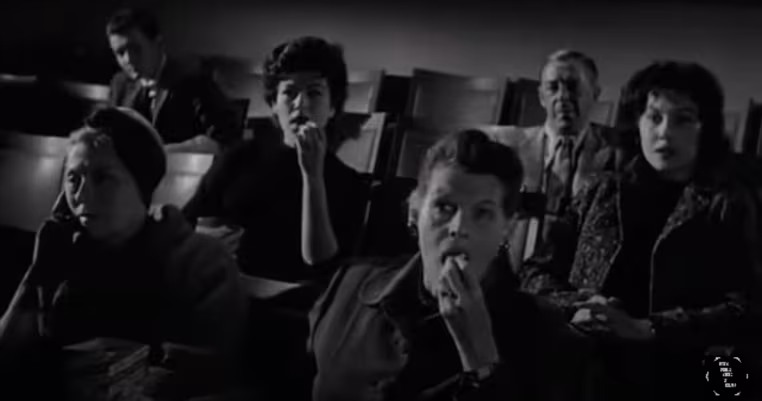
Well, that and one other reason: to get us used to seeing extracts from Tol’able David play on the big screen that would, had we been watching it back in 1959, have been before our very eyes. It just slightly blurs the line between us and the diegetic watchers in the fictional cinema. We are both, in the literal sense, watching Tol’able David.
So when the Tingler escapes into the auditorium, our scientists switch off the lights and the screen goes black – which remember, would plunge a real cinema into darkness. They announce it’s loose in this theatre and ‘a lady has fainted’ and is being carried out – which, for the original audience, would apparently have happened. Castle planted confederates in the crowds.
It doesn’t work as well in a different medium, but that’s not the director’s fault. It must have worked for Castle at the time. I doubt the audience was fooled but it was, just for a moment, a theatrical performance.
Multi-media, you might say.
Then the Tingler gets into the projection booth, and Tol’able David melts on the screen as if our film had got stuck.
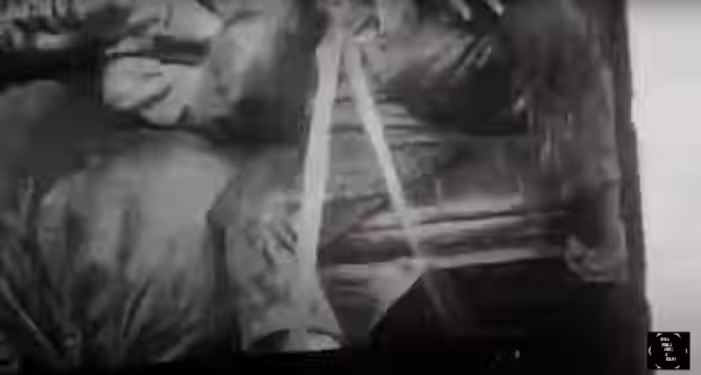
And you know, that’s a good gag if you screen it in the right place. I was lucky enough to see the Chinese horror movie The Eye (2002) in a theatre, and it pulled a similar trick: a few seconds, and then the film apparently got stuck and melted in the projector, the picture failing on the screen. Everyone groaned in frustration. The movie we’d been looking forward to had stopped.
Then BOOM! Ghost appears on the screen. I jumped out of my skin.
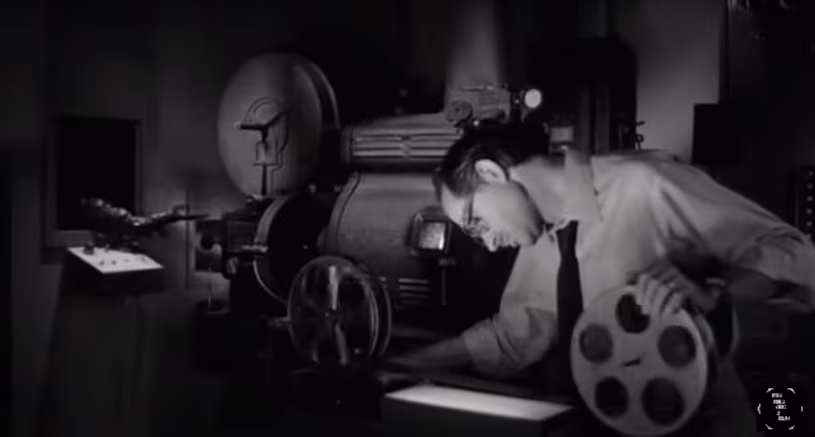
It would have worked better if Castle hadn’t telegraphed it with shots showing us that the beastie is heading into the booth, but it was a good idea nonetheless and the Tingler itself is so charming in its rubbery way that I’d say the effect today is still, well . . . tol’able.
But the other scare setpiece is downright clever.
It involves Mrs Higgins – remember her? the blood-phobic cinema proprietress who can’t scream? – being frightened to death.
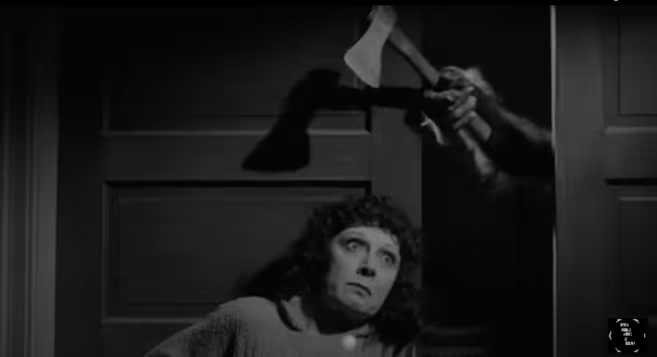
It’s simple enough in concept, and it gets us right back into the funhouse antics of House on Haunted Hill. The unfortunate lady stumbles along through her apartment and jumpscares leap out at her from all angles. They’re so mischievous that today they play as funny – but by that I mean they’re fun, impish, a teasing game Castle is playing against us with great good humour.
And he had one moment of truly clever gimmickry. Remember that Mrs Higgins is scared of blood? And remember that this is a black and white film?
Well, colour film had been invented. So when she goes into the bathroom, she sees THIS!
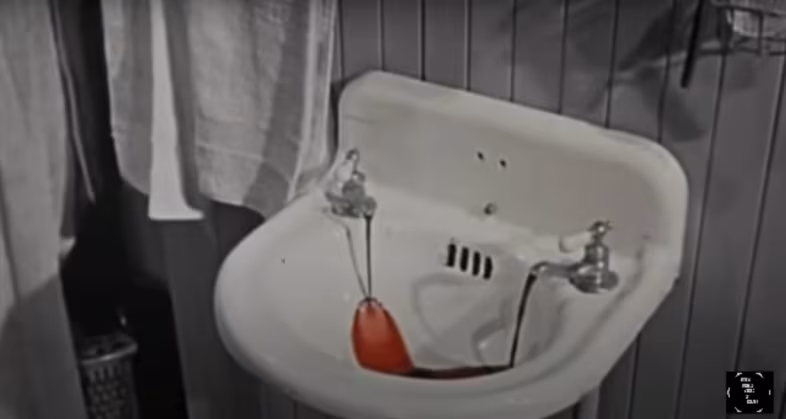
Castle was a low-budget director and he shot in black and white because it was cheap. But when it was worth it, he was prepared to stretch a point. It’s genuinely and delightfully startling, even today.
I’ve talked longer about the lesser movie of the two.
This is because I’d recommend House on Haunted Hill as a fun romp that you’ll enjoy as an actual movie, and it’s more entertaining when you don’t see the twists coming. The Tingler is more a film to marvel at the sheer nerve with which Castle, just to make a climax land, strings us from set piece to set piece without ever admitting that he’s doing sci fi rather than science.
It has a climax we don’t get to enjoy fully unless you’re prepared to invite round your friends and stick some buzzers down the back of your sofa (and if you are, please take pictures and post them, I’d love to see that). It relies not just on a story, but on a prank. But it’s still a joy to watch a skilled gamester deal himself an impossible hand just for the challenge of it, and then play his cards amazingly well.
In terms of gimmicks, these two movies are opposites.
The gimmick in House on Haunted Hill often didn’t work in cinemas at the time and the film plays perfectly fine without it. From what I can gather, The Tingler involved the most elaborate of all Castle’s gimmicks – cinemas started to complain about the trouble and expense after a while – and without it the movie is missing a crucial element. But they both share the same common virtue: they know how to string events together so that you keep following along.
And that’s true whether the events are campy but logical or completely coconuts. House on Haunted Hill’s plot makes perfect sense, at least if you’re prepared to go full Gothic melodrama. The Tingler’s logic falls apart the second you think about it, but Castle keeps you from thinking about it as long as the film lasts, and because the scenes it’s there to justify are played with such gusto it’s impossible to hold a grudge.
Castle knew where it did and didn’t matter – and where it mattered, he got it right.
If you want serious horror he’s not your lad. If anything I suspect his heart of belonging more to pulp sci fi than horror purism, which means the symbolic resonances that horror takes for its meat and drink don’t interest him very much. Both of these movies I’ve just reviewed tend towards the scientific-sounding explanation, and since writing this got me onto a Castle kick I’ve taken in Mr Sardonicus as well (also on YouTube, here you are: https://www.youtube.com/watch?v=njO9yyiScvs&t=5169s, though be warned it’s crawling with unnecessary ads) .
I loved Mr Sardonicus – but while it’s a fabulous romp, just the ticket if you wish James Whale had made more Gothic shockers, it’s takes some clattering brass goolies to make a movie that looks like this:
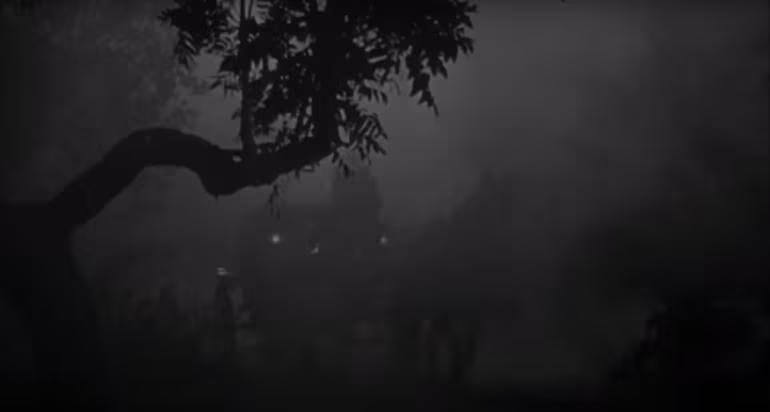
. . . and like this . . .

. . . and introduce us to this servant-torturing, Phantom-of-the-opera-looking mofo . . .
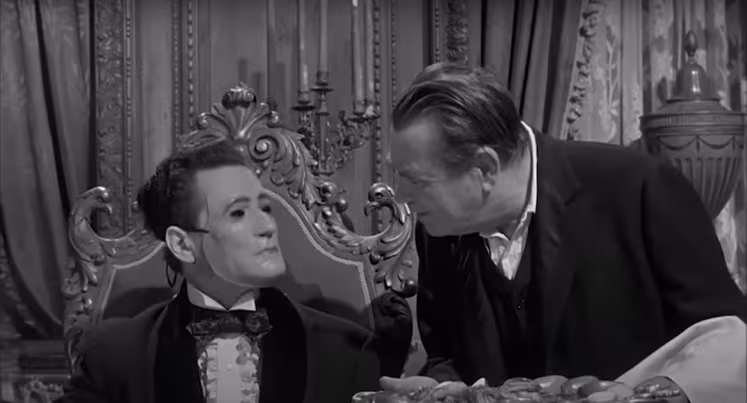
. . . only to tell us with a straight face that ‘his affliction came not from God above, nor from the Fiend below,’ but from psychosomatic symptoms. Castle’s sciency talk and his gimmicks come out of the same aesthetic place: it’s not about magic, it’s about cleverness. Even 13 Ghosts (1960) contains elements of the explained supernatural; that’s where Castle found his fun. He didn’t crave ghosts or monsters, not really. What he loved best was the art of the fake and the trickster.
Narratively as well as cinematically, right down to his mischievous soul, Castle was a man of smoke and mirrors.
So no, don’t look to him for any deep thoughts on the human condition. Artistically, if not for other reasons, it’s a good thing Polanski took over directing Rosemary’s Baby. It would have been a lot hokier in Castle’s hands and it’s an interesting contrast to see how accomplished a director has to be to make such a wild premise play straight. Horror can create psychological and social resonances that ring along your bones, and Castle wasn’t interested in sounding those notes. He just wanted to give them a good rattling.
There are more brilliant film-makers, for sure. Certainly there are many movies less silly.
But if you want to get your pals round, pour a few drinks and have a jolly good time, Castle might turn out to be better than you expect.
And speaking of a good time . . .
Buy my fiction! It’s a great price on Kindle right now! (https://www.amazon.co.uk/dp/B0CCF16MJH?binding=kindle_edition&qid=1733239341&sr=8-1&ref=dbs_dp_rwt_sb_pc_tkin)
Further Reading
Kit Whitfield’s “What’s On Shudder” articles are a must-read for any horror enthusiast looking to enhance their streaming experience. These articles offer a comprehensive guide to the latest and most exciting horror films available on Shudder TV, diving deep into the genre’s rich tapestry. One of the standout features of Whitfield’s work is her unwavering passion for horror, which resonates throughout her writing. She not only highlights key films but also provides insightful commentary on themes, directors, and the evolution of horror as a genre.
Additionally, her articles often include hidden gems and lesser-known films that might be overlooked in the crowded streaming landscape. This can lead to discovering unique stories and innovative filmmaking that challenge conventional horror tropes. Whitfield’s expertise ensures that readers gain a better understanding of the films’ cultural significance and artistic merits.
For both die-hard horror fans and newcomers alike, checking out “What’s On Shudder” is an invaluable resource for finding thought-provoking content that goes beyond mere scares. Her engaging style and knowledgeable perspectives make the horror genre accessible to everyone. Whether you’re in search of a terrifying thrill or a deeper exploration of cinematic horror, Whitfield’s articles are the perfect companion for your Shudder journey.
